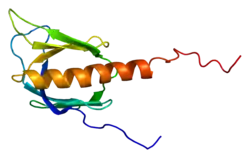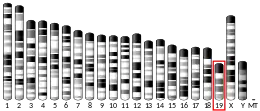G-protein-coupled receptor kinase 2 (GRK2) is an enzyme that in humans is encoded by the ADRBK1 gene.[5] GRK2 was initially called Beta-adrenergic receptor kinase (βARK or βARK1), and is a member of the G protein-coupled receptor kinase subfamily of the Ser/Thr protein kinases that is most highly similar to GRK3(βARK2).[6]
Functions
G protein-coupled receptor kinases phosphorylate activated G protein-coupled receptors, which promotes the binding of an arrestin protein to the receptor. Arrestin binding to phosphorylated, active receptor prevents receptor stimulation of heterotrimeric G protein transducer proteins, blocking their cellular signaling and resulting in receptor desensitization. Arrestin binding also directs receptors to specific cellular internalization pathways, removing the receptors from the cell surface and also preventing additional activation. Arrestin binding to phosphorylated, active receptor also enables receptor signaling through arrestin partner proteins. Thus the GRK/arrestin system serves as a complex signaling switch for G protein-coupled receptors.[7]
GRK2 and the closely related GRK3 phosphorylate receptors at sites that encourage arrestin-mediated receptor desensitization, internalization and trafficking rather than arrestin-mediated signaling (in contrast to GRK5 and GRK6, which have the opposite effect).[8][9] This difference is one basis for pharmacological biased agonism (also called functional selectivity), where a drug binding to a receptor may bias that receptor’s signaling toward a particular subset of the actions stimulated by that receptor.[10][11]
GRK2 is expressed broadly in tissues, but generally at higher levels than the related GRK3.[12] GRK2 was originally identified as a protein kinase that phosphorylated the β2-adrenergic receptor, and has been most extensively studied as a regulator of adrenergic receptors (and other GPCRs) in the heart, where it has been proposed as a drug target to treat heart failure.[13][14] Strategies to inhibit GRK2 include using small molecules (including Paroxetine and Compound-101) and using gene therapy approaches utilizing regulatory domains of GRK2 (particularly overexpressing the carboxy terminal pleckstrin-homology (PH) domain that binds the G protein βγ-subunit complex and inhibits GRK2 activation (often called the “βARKct”), or just a peptide from this PH domain).[15][13]
GRK2 and the related GRK3 can interact with heterotrimeric G protein subunits resulting from GPCR activation, both to be activated and to regulate G protein signaling pathways. GRK2 and GRK3 share a carboxyl terminal pleckstrin homology (PH) domain that binds to G protein βγ subunits, and GPCR activation of heterotrimeric G proteins releases this free βγ complex that binds to GRK2/3 to recruit these kinases to the cell membrane precisely at the location of the activated receptor, augmenting GRK activity to regulate the activated receptor.[16][7] The amino terminal RGS-homology (RH) domain of GRK2 and GRK3 binds to heterotrimeric G protein subunits of the Gq family to reduce Gq signaling by sequestering active G proteins away from their effector proteins such as phospholipase C-beta; but the GRK2 and GRK3 RH domains are unable to function as GTPase-activating proteins (as do traditional RGS proteins) to turn off G protein signaling.[17]
Interactions
GRK2 has been shown to interact with numerous protein partners,[18][19][20] including:
See also
References
- 1 2 3 GRCh38: Ensembl release 89: ENSG00000173020 - Ensembl, May 2017
- 1 2 3 GRCm38: Ensembl release 89: ENSMUSG00000024858 - Ensembl, May 2017
- ↑ "Human PubMed Reference:". National Center for Biotechnology Information, U.S. National Library of Medicine.
- ↑ "Mouse PubMed Reference:". National Center for Biotechnology Information, U.S. National Library of Medicine.
- ↑ Benovic JL, DeBlasi A, Stone WC, Caron MG, Lefkowitz RJ (1989). "Beta-adrenergic receptor kinase: primary structure delineates a multigene family". Science. 246 (4927): 235–240. Bibcode:1989Sci...246..235B. doi:10.1126/science.2552582. PMID 2552582.
- ↑ Benovic JL, Onorato JJ, Arriza JL, et al. (1991). "Cloning, expression, and chromosomal localization of beta-adrenergic receptor kinase 2. A new member of the receptor kinase family". J. Biol. Chem. 266 (23): 14939–14946. doi:10.1016/S0021-9258(18)98568-6. PMID 1869533.
- 1 2 Gurevich VV, Gurevich EV (2019). "GPCR Signaling Regulation: The Role of GRKs and Arrestins". Front Pharmacol. 10: 125. doi:10.3389/fphar.2019.00125. PMC 6389790. PMID 30837883.
- ↑ Kim J, Ahn S, Ren XR, Whalen EJ, Reiter E, Wei H, Lefkowitz RJ (2005). "Functional antagonism of different G protein-coupled receptor kinases for beta-arrestin-mediated angiotensin II receptor signaling". Proc Natl Acad Sci USA. 102 (5): 1442–1447. Bibcode:2005PNAS..102.1442K. doi:10.1073/pnas.0409532102. PMC 547874. PMID 15671181.
- ↑ Ren XR, Reiter E, Ahn S, Kim J, Chen W, Lefkowitz RJ (2005). "Different G protein-coupled receptor kinases govern G protein and beta-arrestin-mediated signaling of V2 vasopressin receptor". Proc Natl Acad Sci USA. 102 (5): 1448–1453. Bibcode:2005PNAS..102.1448R. doi:10.1073/pnas.0409534102. PMC 547876. PMID 15671180.
- ↑ Zidar DA, Violin JD, Whalen EJ, Lefkowitz RJ (2009). "Selective engagement of G protein coupled receptor kinases (GRKs) encodes distinct functions of biased ligands". Proc Natl Acad Sci USA. 106 (24): 9649–9654. Bibcode:2009PNAS..106.9649Z. doi:10.1073/pnas.0904361106. PMC 2689814. PMID 19497875.
- ↑ Choi M, Staus DP, Wingler LM, Ahn S, Pani B, Capel WD, Lefkowitz RJ (2018). "G protein-coupled receptor kinases (GRKs) orchestrate biased agonism at the β2-adrenergic receptor". Sci Signal. 11 (544): eaar7084. doi:10.1126/scisignal.aar7084. PMID 30131371.
- ↑ Arriza JL, Dawson TM, Simerly RB, Martin LJ, Caron MG, Snyder SH, Lefkowitz RJ (1992). "The G-protein-coupled receptor kinases beta ARK1 and beta ARK2 are widely distributed at synapses in rat brain". J Neurosci. 12 (10): 4045–4055. doi:10.1523/jneurosci.12-10-04045.1992. PMC 6575981. PMID 1403099.
- 1 2 Lieu M, Koch WJ (2019). "GRK2 and GRK5 as therapeutic targets and their role in maladaptive and pathological cardiac hypertrophy". Expert Opin Ther Targets. 23 (3): 201–214. doi:10.1080/14728222.2019.1575363. PMID 30701991. S2CID 73413583.
- ↑ Murga C, Arcones AC, Cruces-Sande M, Briones AM, Salaices M, Mayor F Jr (2019). "G Protein-Coupled Receptor Kinase 2 (GRK2) as a Potential Therapeutic Target in Cardiovascular and Metabolic Diseases". Front Pharmacol. 10: 112. doi:10.3389/fphar.2019.00112. PMC 6390810. PMID 30837878.
- ↑ Thal DM, Homan KT, Chen J, Wu EK, Hinkle PM, Huang ZM, Chuprun JK, Song J, Gao E, Cheung JY, Sklar LA, Koch WJ, Tesmer JJ (2012). "Paroxetine is a direct inhibitor of g protein-coupled receptor kinase 2 and increases myocardial contractility". ACS Chem Biol. 7 (11): 1830–1839. doi:10.1021/cb3003013. PMC 3500392. PMID 22882301.
- ↑ Ribas C, Penela P, Murga C, Salcedo A, García-Hoz C, Jurado-Pueyo M, Aymerich I, Mayor F Jr (2007). "The G protein-coupled receptor kinase (GRK) interactome: role of GRKs in GPCR regulation and signaling". Biochim Biophys Acta. 1768 (4): 913–922. doi:10.1016/j.bbamem.2006.09.019. PMID 17084806.
- 1 2 Tesmer VM, Kawano T, Shankaranarayanan A, Kozasa T, Tesmer JJ (2005). "Snapshot of activated G proteins at the membrane: the Galphaq-GRK2-Gbetagamma complex". Science. 310 (5754): 1686–1690. Bibcode:2005Sci...310.1686T. doi:10.1126/science.1118890. PMID 16339447. S2CID 11996453.
- ↑ Hullmann J, Traynham CJ, Coleman RC, Koch WJ (2016). "The expanding GRK interactome: Implications in cardiovascular disease and potential for therapeutic development". Pharmacol Res. 110: 52–64. doi:10.1016/j.phrs.2016.05.008. PMC 4914454. PMID 27180008.
- ↑ Evron T, Daigle TL, Caron MG (March 2012). "GRK2: multiple roles beyond G protein-coupled receptor desensitization". Trends Pharmacol. Sci. 33 (3): 154–164. doi:10.1016/j.tips.2011.12.003. PMC 3294176. PMID 22277298..
- ↑ Penela P, Murga C, Ribas C, Lafarga V, Mayor F Jr (2010). "The complex G protein-coupled receptor kinase 2 (GRK2) interactome unveils new physiopathological targets". Br J Pharmacol. 160 (4): 821–832. doi:10.1111/j.1476-5381.2010.00727.x. PMC 2935989. PMID 20590581.
- ↑ Raveh A, Cooper A, Guy-David L, Reuveny E (November 2010). "Nonenzymatic rapid control of GIRK channel function by a G protein-coupled receptor kinase". Cell. 143 (5): 750–760. doi:10.1016/j.cell.2010.10.018. PMID 21111235.
- ↑ Day PW, Carman CV, Sterne-Marr R, Benovic JL, Wedegaertner PB (August 2003). "Differential interaction of GRK2 with members of the G alpha q family". Biochemistry. 42 (30): 9176–9184. doi:10.1021/bi034442+. PMID 12885252.
- ↑ Premont RT, Claing A, Vitale N, Perry SJ, Lefkowitz RJ (July 2000). "The GIT family of ADP-ribosylation factor GTPase-activating proteins. Functional diversity of GIT2 through alternative splicing". J. Biol. Chem. 275 (29): 22373–22380. doi:10.1074/jbc.275.29.22373. PMID 10896954.
- ↑ Premont RT, Claing A, Vitale N, Freeman JL, Pitcher JA, Patton WA, Moss J, Vaughan M, Lefkowitz RJ (November 1998). "beta2-Adrenergic receptor regulation by GIT1, a G protein-coupled receptor kinase-associated ADP ribosylation factor GTPase-activating protein". Proc. Natl. Acad. Sci. U.S.A. 95 (24): 14082–14087. Bibcode:1998PNAS...9514082P. doi:10.1073/pnas.95.24.14082. PMC 24330. PMID 9826657.
- 1 2 Wan KF, Sambi BS, Tate R, Waters C, Pyne NJ (May 2003). "The inhibitory gamma subunit of the type 6 retinal cGMP phosphodiesterase functions to link c-Src and G-protein-coupled receptor kinase 2 in a signaling unit that regulates p42/p44 mitogen-activated protein kinase by epidermal growth factor". J. Biol. Chem. 278 (20): 18658–18663. doi:10.1074/jbc.M212103200. PMID 12624098.
- ↑ Yang XL, Zhang YL, Lai ZS, Xing FY, Liu YH (April 2003). "Pleckstrin homology domain of G protein-coupled receptor kinase-2 binds to PKC and affects the activity of PKC kinase". World J. Gastroenterol. 9 (4): 800–803. doi:10.3748/wjg.v9.i4.800. PMC 4611453. PMID 12679936.
External links
 Media related to G-protein coupled receptor kinase 2 (beta-adrenergic receptor kinase 1) at Wikimedia Commons
Media related to G-protein coupled receptor kinase 2 (beta-adrenergic receptor kinase 1) at Wikimedia Commons- beta-Adrenergic+Receptor+Kinase at the U.S. National Library of Medicine Medical Subject Headings (MeSH)
- Human ADRBK1 genome location and ADRBK1 gene details page in the UCSC Genome Browser.







